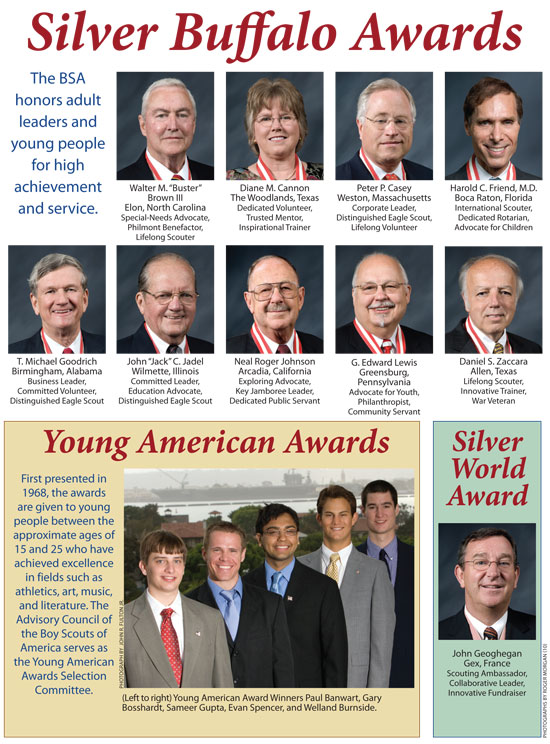A Salute To Our Volunteers
By Scott Daniels
Photograph by John R. Fulton Jr.
The BSA honors its past while planning for the future during its national annual meeting in San Diego.
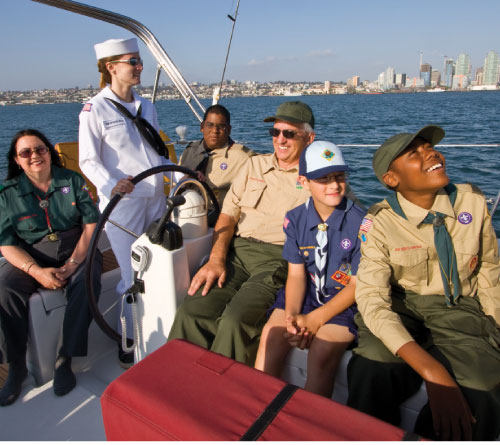 San Diego-Imperial Council youth and leaders set sail on a pleasure cruise aboard the Marilee with the city in the background. (Left to right) associate Advisor Dorothy M. Lorenz of Venturing Crew 1212; Kathryn Malaney of Sea Scout Ship Fiesta Island 1001; Boy Scout Joshua Smith of Troop 816; Scoutmaster Randy Seefeldt of Troop 959; Cub Scout Fabrizio Lacarra of Pack 801; and Boy Scout D.J. Jennings of Troop 2001. |
IT WAS THE SUMMER of 1958 that Bob Mazzuca’s father drank the bug juice — metaphorically, that is.
In telling that story to those gathered at the BSA’s national annual meeting in San Diego, the organization’s Chief Scout Executive didn’t mean the powdered drink mix found in most Scout camps. Rather, he spoke about the realization that comes with discovering the value of volunteerism.
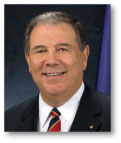 Robert Mazzuca |
“He got it!” Mazzuca said of his father.
It all came about because Mazzuca’s father, an Italian immigrant, owned an old ’49 Studebaker truck. When asked if he could haul Troop 28’s gear to summer camp in Southern California, Mazzuca agreed, and that sparked a magical moment.
“I saw my dad transformed right before my eyes, although I didn’t recognize what was happening,” Mazzuca recalled. “But he connected to what was going on. That was the day, the week, the time that my dad got his first taste of honest-to-God American philanthropy and volunteerism.”
By the fall, Mazzuca’s father was hooked, a member of the troop committee, and serving as—what else?—transportation chairman.
The story served as a fitting tribute in light of the BSA’s emphasis for 2008: The Year of the Volunteer. Nearly 2,200 men and women came to San Diego to reflect on the movement’s accomplishments, learn about its programs and initiatives, and honor its most dedicated volunteers.
A year of achievements
Glenn A. Adams, the new president of the National Eagle Scout Association (NESA), began the meeting’s Americanism Breakfast by paying respect to his predecessor, Steve Fossett. The world-record-holding aviator and adventurer served as the head of NESA until his disappearance last
September in a solo
flight over the Nevada desert.
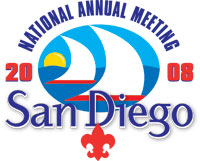 Next, Adams announced that a record-breaking 51,742 boys earned their Eagle Scout rank in 2007. He added that at the current rate of achievement, the BSA’s two millionth Eagle Scout Award probably will be presented in March 2009.
Next, Adams announced that a record-breaking 51,742 boys earned their Eagle Scout rank in 2007. He added that at the current rate of achievement, the BSA’s two millionth Eagle Scout Award probably will be presented in March 2009.
“One of the great things about having more Eagle Scouts, is having more community service projects,” he said.
Last year more than a million people worked on Eagle Scout service projects, donating eight million man hours of service with a total economic impact estimated at $170 million.
“Thousands of people and organizations have benefited from this tremendous outpouring of community service,” Adams said.
Efforts to locate men who earned the Eagle rank and reconnect them with Scouting are having impressive results. “In the past 60 days, 52,000 Eagles have joined NESA. That’s more than 10 times the normal average of about 4,000 we get a year, and this number is increasing by about 300 a day,” Adams reported.
It’s estimated that this search project has identified 90 percent of the more than one million living Eagle Scouts. “This is a vast resource pool for Scouting and will provide all councils many new opportunities to re-engage our alumni,” said Adams.
Everything I learned in Scouting…
The morning’s final speaker, retired Air Force Col. Richard A. Searfoss, compared his experiences as a space shuttle astronaut to preparing for a high adventure Scout trip.
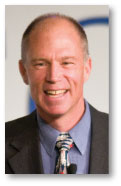 Col. Richard A. Searfoss |
He said there is even a duty roster aboard the space shuttle that tells who makes lunch, just like you’d find in camp.
The three-time space traveler said a shuttle mission provided him marvelous opportunities to apply all the principles found in the Scout Oath and Law.
“The most important things I learned to command a space mission,” he said, “I learned as a 13-year-old senior patrol leader.”
And that included some Scoutcraft ingenuity. Near the end of one mission, as the crew was storing equipment for re-entry, a piece of exercise gear couldn’t be secured to the deck because of a broken latch. As the critical re-entry maneuver approached, time for finding a solution grew short.
“Ground sent me up a six-page fax on how to fix those latches. I said, ‘You know what? I’ve got a better way to do this.’”
The astronaut relayed his fix to Houston, and they approved it, so long as he documented the procedure on videotape. Searfoss grabbed some straps and went to work.
“Let me tell you. That was the tightest diagonal lashing that I’ve ever tied,” he said.
And because Searfoss was an assistant Scoutmaster for a troop in Texas, he grabbed a still camera to show the boys back home, “They can really use their lashings in the real world.”
A look back and forward
Concluding his two-year term as BSA president, Rick Cronk listed some of the organization’s accomplishments in 2007 during the annual business meeting:
- Membership and participation increased to 4.65 million youth.
- Donations to local councils through Friends of Scouting campaigns were up six percent.
- 63 percent of all Scout units received the Centennial Quality Award.
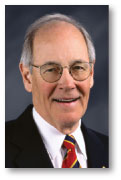 Rick Cronk |
Cronk also mentioned two outreach programs aimed at bringing more youth into Scouting. The first involves the nation’s four leading African-American Baptist Conventions. Its goal is to establish 5,000 new Scout units by 2010. The second consists of a national Hispanic Initiative.
Noting that in California, 48 percent of all Scout-age children are Hispanic, Cronk said, “This is an incredible opportunity to demonstrate how we can positively impact the lives of these young people with the values and the character building that only the Boy Scouts of America offers.”
Bob Mazzuca shared his enthusiasm with the audience for the BSA’s centennial in 2010.
While eager to celebrate the organization’s first 100 years, the Chief Scout Executive cautioned that to only do that would be short-sighted.
“It’s time for us to reintroduce the American people to the Boy Scouts, a Boy Scouts that we define,
not one that’s defined by others. We have such a positive story to tell, and it’s time we told it. We have to use this as an opportunity to stake our claim for the glorious future that is ahead.”
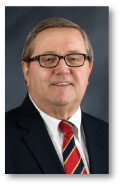 John Gottschalk |
At the awards’ banquet that closed the national meeting, the BSA’s new national president, John Gottschalk, retired CEO and publisher of the Omaha World-Herald, voiced his vision for the organization as it approached its centennial year.
“As we march toward our one-hundredth year, we have a rare oportunity to reposition ourselves to America in a way that speaks to our enduring values in a language of purpose and facts, not myths and suspicions.
“When we do that, we must highlight with emphatic consistency the benefits our programs bring to youth, families, and communities across the nation.
“Volunteers have been the foundation of our movement, with unyielding loyalty and passion for the principles of the Scout Oath and Law.
“Together we can ensure that the fun, the adventure, and the life-changing experiences of Scouting will continue for future generations.”
Scott Daniels is the managing editor of Scouting magazine.
